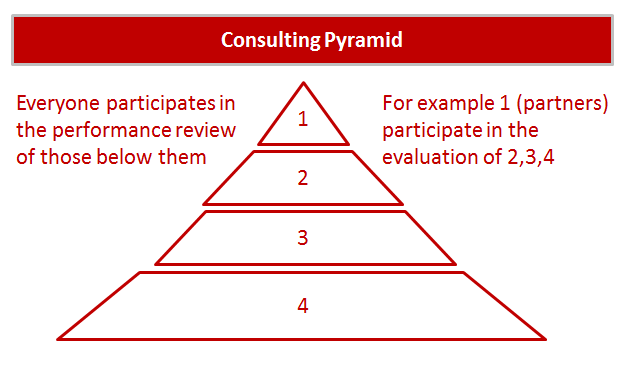Performance reviews
In management consulting, there are performance reviews going on constantly. No seriously. . . constantly. Consulting readers, please disagree. A review for every project. A mid-year review. A year-end review.
- To the optimist, this is an ideal scenario because there is near constant feedback
- To the pessimist, this is exhausting for everyone
While I only have the benefit of working in two consulting groups, the process generally followed this path. Goal setting at the beginning of the year, lots of project reviews (2-5 a year), year-end review with your manager/counselor/advocate, then a consensus (or alignment) meeting in the spring to determine where you fare on the distribution of your grade

Goal Setting
Super important – but typically what you write down on the official paper is just a fraction of what your real goals are. Slight sand-bagging going on here, but of course a great opportunity to see what the partners and principals have planned in the year. Find the white spaces be indispensable. As Seth Godin says, be a linchpin.
Project reviews
Get these done. Don’t let your manager “mail it in” and be lazy. Document what you do, what you did, and the impact your made to the client. The more detailed these are, the easier the year-end process will be for you.
For the managers out there. . . take this #$^@ seriously. Be specific and helpful. Remember the #1 reason people leave their job is because of their boss (manager).
Year-end
This is just painful every year. It is an awkward mix of braggadocio & self-effacing comments. At the end of the day, your utilization and sales need to be high. Lots of practice-development and firm activities. Senior managers, principals and partners must know who you are and want to staff you.
Consensus
There is a rating and ranking process for everyone in the firm. There is a short review/discussion of each person’s performance and then there is a comparison with others in his/her pay-grade or title (e.g., analysts are grouped, managers are grouped etc. . ). As shown in the pyramid below, each person is welcome to participate in the review of those below them in the organization. Partners will sit in on all reviews, while senior managers will sit in on the manager, consultant and analyst reviews.
You learn a lot about people in these meetings. Having sit in on these before, it does sometimes have the feel of a “tribe of elders” or a popularity contest. While there are rules against explicitly cheer-leading for your favorites, this inevitably happens. You see where the friendship, alliances are. You feel who has the passion for the culture of the firm. You see who is selfish or distracted by the process.
 Generally, I am a fan on this process, even though it has not always gone my way. Consulting partnerships are about communication, alignment, and driving firm culture. This is just one of the ways to keep a diverse, disparate group of overly ambitious people working together. Necessary evil.
Generally, I am a fan on this process, even though it has not always gone my way. Consulting partnerships are about communication, alignment, and driving firm culture. This is just one of the ways to keep a diverse, disparate group of overly ambitious people working together. Necessary evil.

Very good overview of the process, I would add one additional thing:
– request additional feedback
Seriously, think about it for a sec: you have 3 super-competetive consultants with similar expierience, they all did well on their projects what is reflected in their formal performance review template. So the chances are that he will pick the one who in his opinion had the most challenging project, or did slightly better than the other two, but it’s all very subjective and his decision is based on the information available in the performance form which is often limited to ‘project goals’, ‘supervisor evaluation’ and ‘self evaluation’. Suppose that one of those guys has included there additional feedback from a senior manager who was on the project, and the feedback is favourable. Will he stand a greater chance? He will. Is this a big hassle? It’s not, might feel silly at the begining but later on it will be your standard practice.
Agreed – it cannot help but be a somewhat subjective process. As a consultant – only makes sense to provide as much 3rd party – data, and documentation that validates what your looking to prove. Good point.